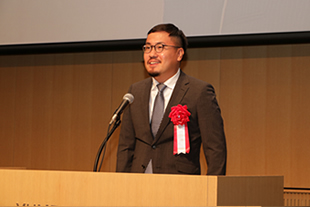 The 21st Asia Pacific Research Prize winner: Dr. Toru Otani
The 21st Asia Pacific Research Prize winner: Dr. Toru Otani
Title of Dissertation: “Study of Wuchang Gui:Process of Transition from Monster to God”

- Toru Otani
-
- Career -
Toru Otani was born in Sapporo in 1989. He is a PhD and specializes in Chinese folklore. He graduated from the Department of Chinese Studies, Faculty of Letters, Chuo University, in 2012, and completed the Master’s program in the Department of Asian Cultural Studies, Graduate School of International Cultural Studies, Tohoku University, in 2014. From 2015 to 2017, he was a research fellow (DC2) of the Japan Society for the Promotion of Science. After studying as a PhD researcher at the College of Humanities, Xiamen University, China, from 2017 to 2020, he completed the doctoral program in the Department of Asian Cultural Studies, Graduate School of International Cultural Studies, Tohoku University, in 2022. He is currently a fellow at the Graduate School of International Cultural Studies, Tohoku University.
- Summary -
This article aims to firmly establish monster studies as a distinct field of research in Chinese studies. This is based on my awareness that the abundant resources related to monsters in China (such as oral traditions concerning monsters) have not yet been tapped effectively. In this article, my intention was to utilize those neglected resources for the practice of monster studies in order to show that conventional Chinese cultural studies can be updated.Against this background, the article critically discusses the trichotomous analytical framework of “gods” “ghosts” and “ancestors” advocated by American anthropologists, and the theme of “From ghosts to gods” derived from this framework. Those preceding studies reduced the Chinese concept of “gui (ghosts)” simply to that of “guhun yegui” (“unattended, wild ghosts”) of human origin, neglecting the existence of nonhuman jingguai (monsters). Therefore, this article examines examples of jingguai being transformed into shen (gods) to explore the position of monsters in Chinese folk beliefs.
To deal with these questions, for this article, I have chosen messengers sent from the other world to arrest souls called “wuchang gui” (which SAWADA Mizuho called “god of death”) as the focus of examination. This is because various examples reveal traces of wuchang gui transformation from jingguai (monsters) to shen (gods). While this hypothesis is clearly distinguished from the generally accepted theory on wuchang gui, the historical transformation of wuchang gui has never been thoroughly examined.
This article tries to shed light on that historical transformation based on detailed inquiries into the wide range of texts on wuchang gui and fieldwork on today’s synchronic juxtaposition of their various images (such as shrine statues and folklore).
As a result, it has been revealed that wuchang gui are a kind of monstrous messengers from the other world that originated from jingguai, such as shanxiao and mobi gui. Furthermore, this article has succeeded in showing the process where the current public image of wuchang gui as gods has been created in parallel with the gradual dilution of their monstrous nature.
I am confident that the attempt made in this article has considerable significance for the subsequent development of research because, despite leaving several challenges unsolved, it has submitted specific proposals for a new methodology and possibilities for Chinese monster studies.






